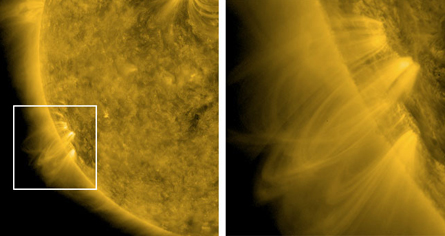Fountainlike jets of hot gas that shoot into the sun’s outer atmosphere may explain why this outlying region is millions of degrees hotter than the sun’s roiling surface — a puzzle that researchers have struggled to explain since they first took the solar corona’s temperature seven decades ago.

The newly discovered jets, too narrow and short-lived to have been seen with older instruments, were imaged in visible light by a high-resolution telescope aboard Japan’s Hinode craft, launched in 2006. Ultraviolet observations with NASA’s recently launched Solar Dynamics Observatory revealed that just seconds after the appearance of the jets in the sun’s chromosphere — the region just above the visible surface — the outer atmosphere, or corona, briefly brightened at temperatures ranging from 100,000 to as high as 2 million kelvins.
Although only a small fraction of the jets may carry hot gas, calculations show that the jets can transport enough high-temperature material to keep the corona heated to several million kelvins, says Bart De Pontieu of the Lockheed Martin Solar and Astrophysics Laboratory in Palo Alto, Calif. He and his colleagues describe their findings in the Jan. 7 Science.
“This is an important and startling breakthrough in understanding how the solar corona may be heated, and I am certainly convinced by it,” comments solar researcher Eric Priest of the University of St. Andrews in Scotland.
Researchers had assumed that the corona acquires its heat from interactions that occur in that outer region — for instance, from the energy unleashed when tangled magnetic fields in the corona snap like rubber bands and reconnect. But the new observations suggest instead that high-speed jets of gas originating in the chromosphere are heated to high temperatures before they arrive at the corona, providing a substantial source of hot gas to the sun’s outer atmosphere, Priest notes.
Solar physicists had known about bigger, slower jets of gas in the chromosphere for decades, says De Pontieu, but these had been discounted as a heat source because studies showed that they did not reach the high temperatures typical of the corona. It took a new generation of solar-staring craft to discover the faster, narrower and shorter-lived jets that not only reach high temperatures but zoom to higher altitudes, he adds.
De Pontieu cautions that the coronal puzzle isn’t entirely solved, because no one knows what produces the jets or how the gas gets heated. Theorist Spiro Antiochos of NASA’s Goddard Space Flight Center in Greenbelt, Md., concurs with that view. “This is a great step forward,” he says, but “we still need a strong theoretical understanding of the processes that are going on.”
A detailed understanding of how the corona is heated should provide a more accurate assessment of how much X-ray and ultraviolet light the sun radiates, which has a profound impact on the extent and density of Earth’s upper atmosphere, says Antiochos. It’s also likely that any mechanism that can explain the sun’s hot corona could account for the high-temperature coronas of other stars, he adds.
One possibility that could now be tested, says Priest, is that tens of thousands of small bundles of magnetic fields known to carpet the sun’s surface ( SN: 11/8/97, p. 295 ) may power the jets. The energy released when these bundles move around the sun and become stretched or tangled might provide enough oomph to explain the jets, he suggests.






